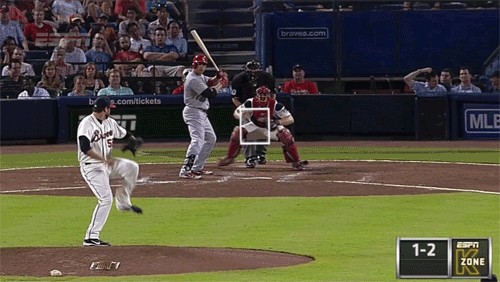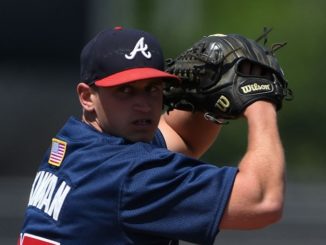Last week, I graded the 2014 Atlanta Braves position players. Today, we look at the pitching staff. We’re all aware that without the very good starting pitching this year, this team may have actually finished worse than they did. And, while the bullpen did go through a couple of stretches in which they struggled, it was largely a very serviceable group.
The Starters: A-
The Braves’ starters led MLB with 110 Quality Starts this season. While it can be argued that the QS stat isn’t as impressive as it sounds (translates to a potential 4.50 ERA), it does give a very superficial gauge of whether your starters gave you a chance to win when they took the mound. The Braves’ starters ranked 5th in MLB in ERA, 6th overall in FIP, and 10th overall in xFIP. They ranked 6th in Runs Allowed per game (3.69), and only the San Diego Padres’ starters saw less run support in MLB. The Braves’ starters were given only 3.5 Runs per Game in offensive support.

Julio Teheran (Grade: A) turned out to be the ‘ace’ everyone was clamoring for, and nearly met my projection for the year. Had the offense bothered to show up this season, he would have easily surpassed it. Teheran went 14-13 with a 2.89 ERA / 3.49 FIP, and was worth 3.2 WAR this season. Teheran took the hill 33 times and tossed 221 innings, which is a ton in this age of larger staffs and pitch counts. Given that he only made $800,00 this year, the Braves had one of the best bargains in baseball this season.
Ervin Santana (Grade: B) was an emergency signing, meant as a hedge against the season-ending elbow injuries suffered by Kris Medlen and Brandon Beachy. Santana came at a hefty price ($14.1M), but he was largely worth the roster spot. Santana posted a 14-10 record, with a 3.95 ERA that seems a little high, based on how he actually pitched (3.39 FIP). He kept the ball in the park better, posting a career low in HR/9 (0.73). In addition to being arguably the most consistent starter, Santana served as a mentor of sorts for some of the young pitchers, showing them different ways to throw certain pitches and providing veteran insight.
Aaron Harang (Grade: B) was another emergency signing, albeit one with a much smaller cost ($1.2M). Harang was released at his request near the end of spring training when it became clear that the Cleveland Indians were not planning to offer him a spot in their rotation. Atlanta swooped in and offered Harang a chance to make the team after the injuries to Beachy and Medlen, and the veteran didn’t disappoint. All season, I was waiting for the smoke and mirrors act to collapse, but it never fully collapsed. Oh, there was some tilting and leaning, to be sure, but no full collapse. The 13-year vet, in his age 36 season, posted a career best 3.57 ERA that exactly matched his 3.57 FIP. He posted the 4th highest innings count of his carer (204.1 IP), and his HR/9 and HR/FB rates were the lowest of his career (a LARGE reason why he was good this year). Not much was expected of Harang, and some (admittedly, I was one) thought that he was going to regress with a vengeance as the year wore on. But, it didn’t happen, and Aaron Harang became probably the best value signing in baseball this year, and possibly of the decade. Harang certainly bought himself a couple of more years and several more millions with this season’s performance.
Alex Wood (Grade: A) was bounced between the bullpen and the rotation again this year, but he still managed to go 8-10 in 24 starts. his ERA as a starter was a very stellar 2.59, with a solid 3.23 FIP. Wood had the highest K/9 rate of the starters (8.69), which helped him to also lead the starters in LOB % (% of runners Left on Base). His line Drive Rate was down, but his ground ball rate was also down. Still, Wood may have been the most consistently good starter for the Braves this year. And, at $506,000 or so this past year, he was a bargain.
Mike Minor (Grade: C) began the season late due to a minor surgery to his…uh….to a non-pitching part of his anatomy:
Mike Minor is a few weeks behind because he had to rest for a month after undergoing a 12/31 procedure to repair scarring around his urethra
— Mark Bowman (@mlbbowman) February 24, 2014
Given the injuries to Beachy and Medlen, it is plausible to believe that Minor may have been asked, or forced himself, to come back sooner than he was ready. For the season, Minor was 6-12 with a 4.77 ERA (4.39 FIP / 3.90 xFIP) in 24 starts. In April and August, Minor was a combined 4-5/3.32 ERA in 11 starts. The rest of the season, however, was pretty bad.
Gavin Floyd (Grade: A-/Inc) and David Hale (Grade: A-/Inc) were both very good in their limited appearances as starters. The duo combined to go 4-3 with a 2.58 ERA in 15 starts. They posted a combined 3.73 FIP as well. Floyd’s season was ended with a fractured olecranon (broken elbow). Hale was moved to the bullpen to provide depth.
The Relievers B
As a group, the Braves’ relievers ranked 11th in MLB in ERA (3.31) and 4th in MLB in FIP (3.21). Only the Marlins and Nationals posted a lower HR/FB rate (6.8%) among MLB relieving corps.
Craig Kimbrel (Grade: A+) was, for the first time in his career thus far, not the best relief pitcher in baseball history. He was simply one of the best in baseball this year. Kimbrel had 47 saves in 51 opportunities (92%); only Aroldis Chapman had a better conversion rate. Kimbrel posted a 1.61 ERA with a 1.83 FIP. He did have control issues on occasion this season (3.79 BB/9), but as a whole, Kimbrel continued his dominance as one of the top closers in baseball.
David Carpenter (Grade: B) was largely a good pitcher this season, going 6-4 with a 3.54 ERA., but you wouldn’t be able to tell it from the comments of many Braves fans. While his ERA was almost 2 full points higher than in 2013 mark (1.78), his 2014 FIP (2.94 and 2013 FIP (2.83) were nearly the same as were his xFIPs (3.11/3.19). he was the same guy throwing the same pitches as last year, for the most part. They just didn’t find gloves like they did last year.
Jordan Walden (Grade: B) was another who was nearly identical to last season. His 2014 ERA was slightly lower than 2013 (2.88 v 3.45), but his FIP was nearly the same (2.79 v 2.81). Walden struck out batters this year at a slightly higher rate, but he walked more than usual. Walden is a very good set up option, and is a viable replacement if Kimbrel were ever not available, having saved 32 games for the Angels in 2011. Did you know he hops when he pitches?
Anthony Varvaro (Grade: B) is another who inexplicably is singled out by many Braves fans as a pitcher the Braves’ must get rid of. By most measures, he actually had a better season this year than he did last season, when he was presumably acceptable (because we won the division). He posted improvements to his ERA, FIP, xFIP, K/9, BB/9 and LOB %. I’m not quite sure why many fans point to him as a poor piece in the bullpen; he’s a very solid, valuable reliever, provided he isn’t used in high leverage situations. But as a guy to use to get your closer or to get some outs as a bridge piece? He’s perfectly acceptable, and a better option than most teams have.
James Russell (Grade: B) was a decent option overall (2.66 ERA / 2.39 FIP). The issue, however, is in how he was used. Russell, is a LHP who, for his career, has been better against LHB than RHB. But this season, for some reason, he was lock-down against RHB (.239 OBP) and terrible against LHB (.351 OBP). One reason that jumps out from his ptch profile: Russell threw far fewer sliders this year than last (20.8% v 37.9%) and threw far more changeups (11.9% v 16.6%) and fastballs (.43.4% v 35.8%). perhaps the straighter pitches were far easier for the LHB to see. Fredi Gonzalez learned after a while that Russell wasn’t the guy this year that he had been, but by then, Russell had already been ineffective in key situations.
Luis Avilan (Grade: D) and David Hale (Grade: D) were both ineffective regular options out of the bullpen. Avilan was 4-1 with a 4.57 ERA (4.24 FIP), and he had control issues all season (4.36 BB/9). His .4% HR/FB rate, while good, was nearly twice his career average. He also could not get LHB out this season, something he has been able to do well in the past. Avilan this year threw fewer curveballs and, like Russell, more changeups. perhaps the nature of the movement on the changeup from a LHP to a LHB makes it more hittable, as both primary lefties out of the Atlanta ‘pen struggled with LHB this year while also throwing significantly more changeups.
Hale actually walked more at a higher rate than he struck out (3.81 BB/9 v 3.64 K/9). Hale has mentioned before being uncomfortable pitching out of the bullpen, but he shouldn’t, given that he’s been bounced between rotation and ‘pen his entire professional career..






Leave a Reply